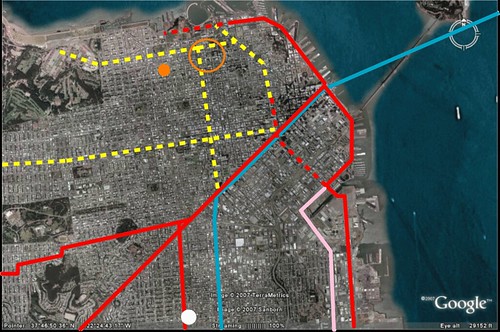Apparently there is a recipe in Houston for anti-rail arguments. Go to any Houston anti-rail site and there is a clearly a template for bashing rail lines. I can see the book now, steps for being against rail in Houston. I noticed some of the many steps in a recent editorial in the
Houston Chronicle.
Step 1: Claim the Light Rail Blocks Traffic and Hogs the Road.
Though the light-rail trains don't often sit still to clog streets, the right-of-way hogs do stifle traffic through downtown and Midtown each day. If the leaders of the Metropolitan Transit Authority have their way, Richmond Avenue will also soon be nearly impassable during rush hours.
Remind me again how many people those LRVs carry versus cars? So who should have priority, a train full of people, or a single occupancy vehicle? Increasing the capacity of Main Street seems to be rather beneficial. The line does get 40,000 riders a day.
Step 2: Transit should be a private enterprise, since cars
always pay for
themselves.
The New York Times, which so often whiffs at attempts to explain Houston to the nation, highlighted the downtown tunnel system recently in a feature story that illustrates how the city works best. "(The tunnel system) was not centrally planned; it just grew," wrote Houston-based reporter Ralph Blumenthal. "And, befitting Texans' distrust of government, most of it is private."
Rule 3: Cite Joel Kotkin or Wendell Cox or RandalL O'Toole as Experts
Light rail and bike paths are but two examples of the current push to shape Houston in the vision of urban planners and civic leaders who hate Houston's now 171-year tradition of organic growth. A debate on such matters has been carried out in this newspaper since urban expert Joel Kotkin told the Greater Houston Partnership early this summer that Houston's embrace of free-market planning was a great example for other cities.
Outsiders like Kotkin seem to have a pretty good view of Houston's workings these days, perhaps even better than its residents.
It always cracks me up that there is no mention of where these guys come from or their motives, just that they are experts. But most people know who these guys are by now.
Rule 4: Houston's Lack of Planning Make it the Greatest City in the USA
Indeed, like the tunnels, Houston wasn't planned so much as it just grew into the nation's fourth-largest city. Now, many would like to see Houston turn its back on the very strategy — that is, nonstrategy — that made the city great.
Rule 5: The Public Process is Flawed Because We the Minority Aren't Getting Our Way
Alas resistance, as they say, is futile. Metro recently held public hearings that allowed opponents of the Richmond rail route to voice their dissent. But surely all those attending the meeting know any words of discord fell on deaf ears.Seemingly nothing can be said that will convince Metro's leaders of anything other than the plan they're forcing on Houston. Those who live and operate businesses along Richmond are told to sacrifice for the "greater good."
I believe over 50% voted for the Metro Solutions light rail plan and most people on Richmond want the rail line. The stats that come from Culbertson's head are just that, in his head.
Rule 6: If It Doesn't Serve Suburban Commuters, It Doesn't Serve Anyone Worth Serving
Never mind that the light rail can't get commuters from the suburbs to their jobs. Or that Houston's decentralized population and wide geographic reach vastly reduce the utility of a static mass transit structure.
Of course they are probably fine with the HOV lane road warrior bus system they created. People in Houston working along the major freeways have an option with those HOV lanes built with
federal funding. Very few people realize that Houston has already spent at least a billion dollars on those spokes. Yet even with those improvements, there was still a need for a crazy expansion of the Katy Freeway, which no one complains about going
over budget.
Rule 7: Call the Rail Line a Name
I know the guy in this article wanted to call the Houston light rail by a name, perhaps danger train or something silly like that, but he had to look credible right?
So take a look at all of these elements of a rail attack piece, does it look like every other attack piece ever done? Of course it does because deep down they just do not like rail and can not just come out and say it. All they have to do is say "I don't like rail". This is not a war of ideas but one of ideology. It's like a virus that has spread from Karl Rove's brain to every aspect of life.
If you have another step, feel free to post it in the comments.

